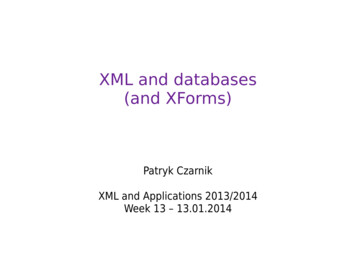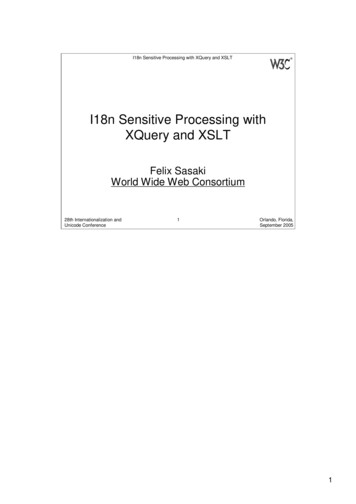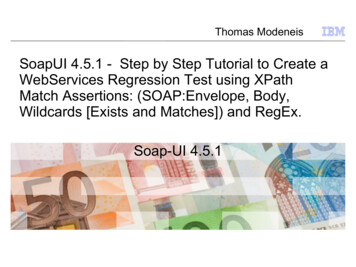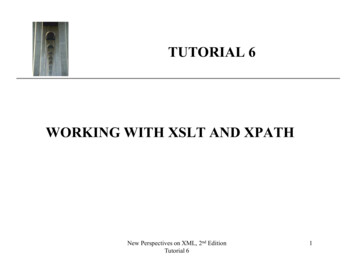
Transcription
XPathAbout the TutorialXPath is a query language that is used for traversing through an XML document. It is usedcommonly to search particular elements or attributes with matching patterns.This tutorial explains the basics of XPath. It contains chapters discussing all the basiccomponents of XPath with suitable examples.AudienceThis tutorials has been designed for beginners to help them understand the basic conceptsrelated to XPath. This tutorial will give you enough understanding on XPath from whereyou can take yourself to higher levels of expertise.PrerequisitesBefore proceeding with this tutorial, you should have basic knowledge of XML, HTML, andJavaScript.Disclaimer & Copyright Copyright 2018 by Tutorials Point (I) Pvt. Ltd.All the content and graphics published in this e-book are the property of Tutorials Point (I)Pvt. Ltd. The user of this e-book is prohibited to reuse, retain, copy, distribute or republishany contents or a part of contents of this e-book in any manner without written consentof the publisher.We strive to update the contents of our website and tutorials as timely and as precisely aspossible, however, the contents may contain inaccuracies or errors. Tutorials Point (I) Pvt.Ltd. provides no guarantee regarding the accuracy, timeliness or completeness of ourwebsite or its contents including this tutorial. If you discover any errors on our website orin this tutorial, please notify us at contact@tutorialspoint.com.i
XPathTable of ContentsAbout the Tutorial . iAudience . iPrerequisites . iDisclaimer & Copyright. iTable of Contents . ii1. XPATH – OVERVIEW . 1Need for XSL. 1What is XPath? . 12. XPATH — EXPRESSION. 3Example . 43. XPATH — NODES . 7XPath Root Node . 7XPath Element Node . 10XPath Text Node . 14XPath Attribute Node . 18XPath Comment Node . 214. XPATH — ABSOLUTE PATH . 245. XPATH — RELATIVE PATH . 27Example . 276. XPATH — AXES. 30Verify the output. 327. XPATH — OPERATORS . 33XPath Comparison Operators . 33ii
XPathXPath Boolean Operators . 36XPath Number Operators / Functions . 39XPath String Functions . 42XPath Node Functions . 458. XPATH — WILDCARD . 49Example . 499. XPATH — PREDICATE. 53Example . 53iii
1.XPath – OverviewBefore learning XPath, we should first understand XSL whichExtensible Stylesheet Language. It is similar to XML as CSS is to HTML.XPathstandsforNeed for XSLIn case of HTML documents, tags are predefined such as table, div, span, etc. The browserknows how to add style to them and display them using CSS styles. But in case of XMLdocuments, tags are not predefined. In order to understand and style an XML document,World Wide Web Consortium (W3C) developed XSL which can act as an XML-basedStylesheet Language. An XSL document specifies how a browser should render an XMLdocument.Following are the main parts of XSL: XSLT — used to transform XML documents into various other types of document. XPath — used to navigate XML documents. XSL-FO — used to format XML documents.What is XPath?XPath is an official recommendation of the World Wide Web Consortium (W3C). It definesa language to find information in an XML file. It is used to traverse elements and attributesof an XML document. XPath provides various types of expressions which can be used toenquire relevant information from the XML document. Structure Definitions — XPath defines the parts of an XML document likeelement, attribute, text, namespace, processing-instruction, comment, anddocument nodes Path Expressions — XPath provides powerful path expressions select nodes orlist of nodes in XML documents. Standard Functions — XPath provides a rich library of standard functions formanipulation of string values, numeric values, date and time comparison, node andQName manipulation, sequence manipulation, Boolean values etc. Major part of XSLT — XPath is one of the major elements in XSLT standard andis must have knowledge in order to work with XSLT documents. W3C recommendation — XPath is an official recommendation of World Wide WebConsortium (W3C).1
XPathOne should keep the following points in mind, while working with XPath: XPath is core component of XSLT standard. XSLT cannot work without XPath. XPath is basis of XQuery and XPointer.2
2.XPath — ExpressionXPathAn XPath expression generally defines a pattern in order to select a set of nodes. Thesepatterns are used by XSLT to perform transformations or by XPointer for addressingpurpose.XPath specification specifies seven types of nodes which can be the output of execution ofthe XPath expression. Root Element Text Attribute Comment Processing Instruction NamespaceXPath uses a path expression to select node or a list of nodes from an XML document.Following is the list of useful paths and expression to select any node/ list of nodes froman XML document.Expressionnode-nameDescriptionSelect all nodes with the given name "nodename"/Selection starts from the root node//Selection starts from the current node that match the selection.Selects the current node.Selects the parent of the current node@Selects attributesstudentExample: Selects all nodes with the name "student"3
XPathclass/student Example: Selects all student elements that are children of class//studentSelects all student elements no matter where they are in the documentExampleIn this example, we've created a sample XML document, students.xml and its stylesheetdocument students.xsl which uses the XPath expressions under select attribute ofvarious XSL tags to get the values of roll no, firstname, lastname, nickname and marks ofeach student node.students.xml ?xml version "1.0"? ?xml-stylesheet type "text/xsl" href "students.xsl"? class student rollno "393" firstname Dinkar /firstname lastname Kad /lastname nickname Dinkar /nickname marks 85 /marks /student student rollno "493" firstname Vaneet /firstname lastname Gupta /lastname nickname Vinni /nickname marks 95 /marks /student student rollno "593" firstname Jasvir /firstname lastname Singh /lastname nickname Jazz /nickname marks 90 /marks /student /class 4
XPathstudents.xsl ?xml version "1.0" encoding "UTF-8"? xsl:stylesheet version "1.0"xmlns:xsl "http://www.w3.org/1999/XSL/Transform" xsl:template match "/" html body h2 Students /h2 table border "1" tr bgcolor "#9acd32" th Roll No /th th First Name /th th Last Name /th th Nick Name /th th Marks /th /tr xsl:for-each select "class/student" tr td xsl:value-of select "@rollno"/ /td td xsl:value-of select "firstname"/ /td td xsl:value-of select "lastname"/ /td td xsl:value-of select "nickname"/ /td td xsl:value-of select "marks"/ /td /tr /xsl:for-each /table /body /html /xsl:template /xsl:stylesheet 5
XPathVerify the output6
3.XPath — NodesXPathIn this chapter, we'll see the XPath expression in details covering common types of Nodes,XPath defines and handles.S.N.12345Node Type & DescriptionRootRoot element node of an XML Document.ElementElement node.TextText of an element node.AttributeAttribute of an element node.CommentCommentLet us now understand the nodes in detail.XPath Root NodeFollowing are the ways to get root element and do the processing afterwards.Use WildcardUse /*, wild card expression to select the root node. p xsl:value-of select "name(/*)"/ /p Use NameUse /class, to select root node by name. p xsl:value-of select "name(/class)"/ /p 7
XPathUse Name with wild cardUse /class/*, select all element under root node. p xsl:value-of select "name(/class/*)"/ /p ExampleIn this example, we've created a sample XML document students.xml and its stylesheetdocument students.xsl which uses the XPath expressions.Following is the sample XML used.students.xml ?xml version "1.0"? ?xml-stylesheet type "text/xsl" href "students.xsl"? class student rollno "393" firstname Dinkar /firstname lastname Kad /lastname nickname Dinkar /nickname marks 85 /marks /student student rollno "493" firstname Vaneet /firstname lastname Gupta /lastname nickname Vinni /nickname marks 95 /marks /student student rollno "593" firstname Jasvir /firstname lastname Singh /lastname nickname Jazz /nickname marks 90 /marks /student /class 8
XPathstudents.xsl ?xml version "1.0" encoding "UTF-8"? xsl:stylesheet version "1.0"xmlns:xsl "http://www.w3.org/1999/XSL/Transform" xsl:template match "/" html body h3 Root Element. Xpath expression "/*" /h3 p xsl:value-of select "name(/*)"/ /p h3 Root Element. Xpath expression "/class" /h3 p xsl:value-of select "name(/class)"/ /p h3 Details of each Students. Xpath expression "/class/*" /h3 table border "1" tr bgcolor "#9acd32" th Roll No /th th First Name /th th Last Name /th th Nick Name /th th Marks /th /tr xsl:for-each select "/class/*" tr td xsl:value-of select "@rollno"/ /td td xsl:value-of select "firstname"/ /td td xsl:value-of select "lastname"/ /td td xsl:value-of select "nickname"/ /td td xsl:value-of select "marks"/ /td /tr /xsl:for-each /table /body /html /xsl:template /xsl:stylesheet 9
XPathVerify the output10
XPathEnd of ebook previewIf you liked what you saw Buy it from our store @ https://store.tutorialspoint.com11
This tutorial explains the basics of XPath. It contains chapters discussing all the basic components of XPath with suitable examples. Audience This tutorials has been designed for beginners to help them understand the basic concepts related to XPath. This tutorial will give you enough understanding on XPath from where










